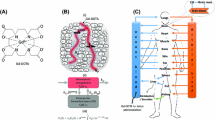Abstract
Intra-arterial (IA) drug delivery has been proposed for the treatment of a wide range of brain diseases, including malignant brain tumors. However, pharmacokinetic optimization for IA drug delivery to the brain remains a challenge. In this report, we apply and expand the well-established Dedrick model of IA drug delivery to the brain and test the effects of modifying drug and delivery parameters. These simulations show that altering the properties of candidate drugs and physiological variables can have profound effects on regional deposition after IA injections. We show that drug and physiological optimization aimed at rapid drug extraction and sustained retention is necessary to maximize regional deposition after of IA injections.




Similar content being viewed by others
References
Joshi S, Ellis JA, Emala CW. Revisiting intra-arterial drug delivery for treating brain diseases or is it “déjà- vu, all over again”? J Neuroanaesthesiol Crit Care. 2014;1(2):108–15.
Ellis JA, Banu M, Hossain SS, Singh-Moon R, Lavine SD, Bruce JN, et al. Reassessing the role of intra-arterial drug delivery for glioblastoma multiforme treatment. J Drug Deliv. 2015;2015:405735. doi:10.1155/2015/405735.
Joshi S, Ellis JA, Ornstein E, Bruce JN. Intraarterial drug delivery for glioblastoma mutiforme: will the phoenix rise again? J Neuro-Oncol. 2015;124(3):333–43. doi:10.1007/s11060-015-1846-6.
Joshi S, Emala CW, Pile-Spellman J. Intra-arterial drug delivery: a concise review. J Neurosurg Anesthesiol. 2007;19(2):111–9.
Joshi S, Meyers PM, Ornstein E. Intracarotid delivery of drugs: the potential and the pitfalls. Anesthesiology. 2008;109(3):543–64.
Pardridge WM. Drug delivery to the brain. J Cereb Blood Flow Metab. 1997;17(7):713–31.
Neuwelt E. Implications of the blood-brain-barrier and its manipulation. Plenum New York. 1988;223-60.
Neuwelt E, Abbott NJ, Abrey L, Banks WA, Blakley B, Davis T, et al. Strategies to advance translational research into brain barriers. Lancet Neurol. 2008;7(1):84–96.
Greig NH, Daly EM, Sweeney DJ, Rapoport SI. Pharmacokinetics of chlorambucil-tertiary butyl ester, a lipophilic chlorambucil derivative that achieves and maintains high concentrations in brain. Cancer Chemother Pharmacol. 1990;25(5):320–5.
Pardridge WM. Lipid mediated transport and carrier-mediated transport. In: Pardridge WM, editor. Brain drug targeting: the future of drug development. Cambridge: Cambridge University Press; 2010. p. 36–81.
Jones DR, Hall SD, Jackson EK, Branch RA, Wilkinson GR. Brain uptake of benzodiazepines: effects of lipophilicity and plasma protein binding. J Pharmacol Exp Ther. 1988;245(3):816–22.
Eckman WW, Patlak CS, Fenstermacher JD. A critical evaluation of the principles governing the advantages of intra-arterial infusions. J Pharmacokinet Biopharm. 1974;2(3):257–85.
Dedrick RL. Arterial drug infusion: pharmacokinetic problems and pitfalls. J Natl Cancer Inst. 1988;80(2):84–9.
Liu Y, Shah S, Tan J. Computational modeling of nanoparticle targeted drug delivery. Rev Nanosci Nanotechnol. 2012;1:66–83.
Hossain S, Chowdhury EH, Akaike T. Nanoparticles and toxicity in therapeutic delivery: the ongoing debate. Ther Deliv. 2011;2(2):125–32.
Hossain SS, Hughes TJ, Decuzzi P. Vascular deposition patterns for nanoparticles in an inflamed patient-specific arterial tree. Biomech Model Mechanobiol. 2013. doi:10.1007/s10237-013-0520-1.
Hossain SS, Zhang Y, Liang X, Hussain F, Ferrari M, Hughes TJ, et al. In silico vascular modeling for personalized nanoparticle delivery. Nanomedicine. 2013;8(3):343–57. doi:10.2217/nnm.12.124.
Gallo JM, Vicini P, Orlansky A, Li S, Zhou F, Ma J, et al. Pharmacokinetic model-predicted anticancer drug concentrations in human tumors. Clin Cancer Res : Off J Am Assoc Cancer Res. 2004;10(23):8048–58. doi:10.1158/1078-0432.CCR-04-0822.
Joshi S, Singh-Moon R, Wang M, Bruce JN, Bigio IJ, Mayevsky A. Real-time hemodynamic response and mitochondrial function changes with intracarotid mannitol injection. Brain Res. 2014;1549:42–51. doi:10.1016/j.brainres.2013.12.036.
Nguyen J, Cooke JR, Ellis JA, Deci M, Emala CW, Bruce JN, et al. Cationizable lipid micelles as vehicles for intraarterial glioma treatment. J Neuro-Oncol. 2016. doi:10.1007/s11060-016-2088-y.
Raghunand N, Mahoney BP, Gillies RJ. Tumor acidity, ion trapping and chemotherapeutics. II. pH-dependent partition coefficients predict importance of ion trapping on pharmacokinetics of weakly basic chemotherapeutic agents. Biochem Pharmacol. 2003;66(7):1219–29.
Joshi S, Young WL, Pile-Spellman J, Duong DH, Vang MC, Hacein-Bey L, et al. The feasibility of intracarotid adenosine for the manipulation of human cerebrovascular resistance. Anesth Analg. 1998;87:1291–8.
Joshi S, Hartl R, Wang M, Feng L, Hoh D, Sciacca RR, et al. The acute cerebrovascular effects of intracarotid adenosine in nonhuman primates. Anesth Analg. 2003;97(1):231–7.
Joshi S, Duong H, Mangla S, Wang M, Libow AD, Popilskis SJ, et al. In nonhuman primates intracarotid adenosine, but not sodium nitroprusside. Increases Cerebral Blood Flow Anesth Analg. 2002;94(2):393–9.
Joshi S, Wang M, Etu JJ, Nishanian EV, Pile-Spellman J. Cerebral blood flow affects dose requirements of intracarotid propofol for electrocerebral silence. Anesthesiology. 2006;104(2):290–8.
Joshi S, Wang M, Etu JJ, Pile-Spellman J. Reducing cerebral blood flow increases the duration of electroencephalographic silence by intracarotid thiopental. Anesth Analg. 2005;101(3):851–8.
Joshi S, Wang M, Etu JJ, Suckow RF, Cooper TB, Feinmark SJ, et al. Transient cerebral hypoperfusion enhances intraarterial carmustine deposition into brain tissue. J Neuro-Oncol. 2007.
Joshi S, Singh-Moon RP, Wang M, Chaudhuri DB, Holcomb M, Straubinger NL, et al. Transient cerebral hypoperfusion assisted intraarterial cationic liposome delivery to brain tissue. J Neuro-Oncol. 2014. doi:10.1007/s11060-014-1421-6.
Author information
Authors and Affiliations
Corresponding author
Ethics declarations
All experiments reported comply with the current laws of the USA. All experiments were approved by the Columbia University Institutional Review Board.
Conflict of interest
The authors declare that they have no conflict of interest.
Funding
The study was funded by the National Cancer Institute at the National Institutes of Health RO1-CA-138643.
Rights and permissions
About this article
Cite this article
Cooke, J.N.R., Ellis, J.A., Hossain, S. et al. Computational pharmacokinetic rationale for intra-arterial delivery to the brain. Drug Deliv. and Transl. Res. 6, 622–629 (2016). https://doi.org/10.1007/s13346-016-0319-6
Published:
Issue Date:
DOI: https://doi.org/10.1007/s13346-016-0319-6




